Tingwu Wang
University of Toronto, Nvidia
Synthesizing Physical Character-Scene Interactions
Feb 02, 2023Abstract:Movement is how people interact with and affect their environment. For realistic character animation, it is necessary to synthesize such interactions between virtual characters and their surroundings. Despite recent progress in character animation using machine learning, most systems focus on controlling an agent's movements in fairly simple and homogeneous environments, with limited interactions with other objects. Furthermore, many previous approaches that synthesize human-scene interactions require significant manual labeling of the training data. In contrast, we present a system that uses adversarial imitation learning and reinforcement learning to train physically-simulated characters that perform scene interaction tasks in a natural and life-like manner. Our method learns scene interaction behaviors from large unstructured motion datasets, without manual annotation of the motion data. These scene interactions are learned using an adversarial discriminator that evaluates the realism of a motion within the context of a scene. The key novelty involves conditioning both the discriminator and the policy networks on scene context. We demonstrate the effectiveness of our approach through three challenging scene interaction tasks: carrying, sitting, and lying down, which require coordination of a character's movements in relation to objects in the environment. Our policies learn to seamlessly transition between different behaviors like idling, walking, and sitting. By randomizing the properties of the objects and their placements during training, our method is able to generalize beyond the objects and scenarios depicted in the training dataset, producing natural character-scene interactions for a wide variety of object shapes and placements. The approach takes physics-based character motion generation a step closer to broad applicability.
Physics-based Human Motion Estimation and Synthesis from Videos
Sep 21, 2021



Abstract:Human motion synthesis is an important problem with applications in graphics, gaming and simulation environments for robotics. Existing methods require accurate motion capture data for training, which is costly to obtain. Instead, we propose a framework for training generative models of physically plausible human motion directly from monocular RGB videos, which are much more widely available. At the core of our method is a novel optimization formulation that corrects imperfect image-based pose estimations by enforcing physics constraints and reasons about contacts in a differentiable way. This optimization yields corrected 3D poses and motions, as well as their corresponding contact forces. Results show that our physically-corrected motions significantly outperform prior work on pose estimation. We can then use these to train a generative model to synthesize future motion. We demonstrate both qualitatively and quantitatively significantly improved motion estimation, synthesis quality and physical plausibility achieved by our method on the large scale Human3.6m dataset \cite{h36m_pami} as compared to prior kinematic and physics-based methods. By enabling learning of motion synthesis from video, our method paves the way for large-scale, realistic and diverse motion synthesis.
UniCon: Universal Neural Controller For Physics-based Character Motion
Nov 30, 2020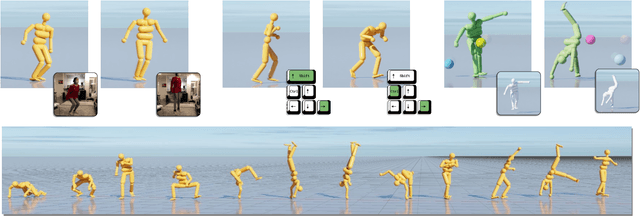
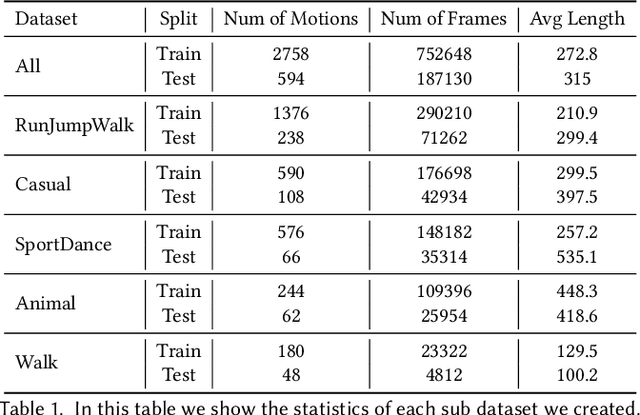
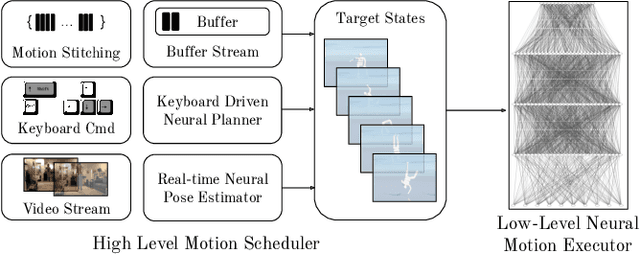

Abstract:The field of physics-based animation is gaining importance due to the increasing demand for realism in video games and films, and has recently seen wide adoption of data-driven techniques, such as deep reinforcement learning (RL), which learn control from (human) demonstrations. While RL has shown impressive results at reproducing individual motions and interactive locomotion, existing methods are limited in their ability to generalize to new motions and their ability to compose a complex motion sequence interactively. In this paper, we propose a physics-based universal neural controller (UniCon) that learns to master thousands of motions with different styles by learning on large-scale motion datasets. UniCon is a two-level framework that consists of a high-level motion scheduler and an RL-powered low-level motion executor, which is our key innovation. By systematically analyzing existing multi-motion RL frameworks, we introduce a novel objective function and training techniques which make a significant leap in performance. Once trained, our motion executor can be combined with different high-level schedulers without the need for retraining, enabling a variety of real-time interactive applications. We show that UniCon can support keyboard-driven control, compose motion sequences drawn from a large pool of locomotion and acrobatics skills and teleport a person captured on video to a physics-based virtual avatar. Numerical and qualitative results demonstrate a significant improvement in efficiency, robustness and generalizability of UniCon over prior state-of-the-art, showcasing transferability to unseen motions, unseen humanoid models and unseen perturbation.
Learning to Generate Diverse Dance Motions with Transformer
Aug 18, 2020


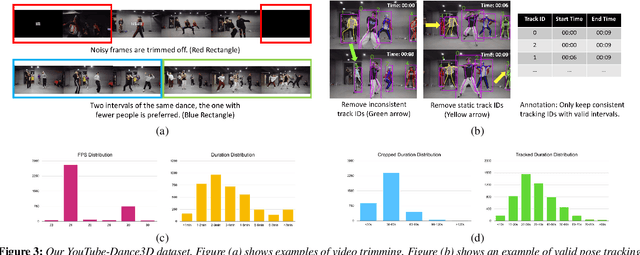
Abstract:With the ongoing pandemic, virtual concerts and live events using digitized performances of musicians are getting traction on massive multiplayer online worlds. However, well choreographed dance movements are extremely complex to animate and would involve an expensive and tedious production process. In addition to the use of complex motion capture systems, it typically requires a collaborative effort between animators, dancers, and choreographers. We introduce a complete system for dance motion synthesis, which can generate complex and highly diverse dance sequences given an input music sequence. As motion capture data is limited for the range of dance motions and styles, we introduce a massive dance motion data set that is created from YouTube videos. We also present a novel two-stream motion transformer generative model, which can generate motion sequences with high flexibility. We also introduce new evaluation metrics for the quality of synthesized dance motions, and demonstrate that our system can outperform state-of-the-art methods. Our system provides high-quality animations suitable for large crowds for virtual concerts and can also be used as reference for professional animation pipelines. Most importantly, we show that vast online videos can be effective in training dance motion models.
Benchmarking Model-Based Reinforcement Learning
Jul 03, 2019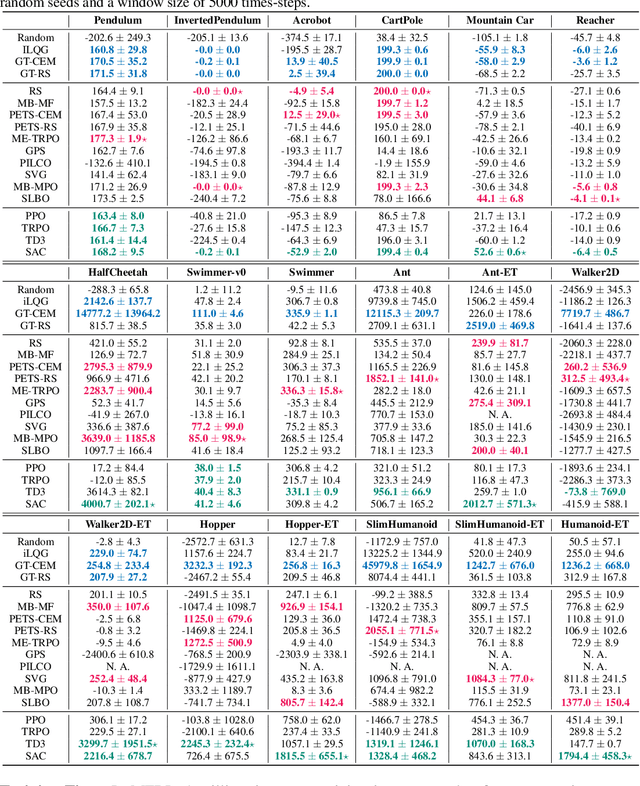



Abstract:Model-based reinforcement learning (MBRL) is widely seen as having the potential to be significantly more sample efficient than model-free RL. However, research in model-based RL has not been very standardized. It is fairly common for authors to experiment with self-designed environments, and there are several separate lines of research, which are sometimes closed-sourced or not reproducible. Accordingly, it is an open question how these various existing MBRL algorithms perform relative to each other. To facilitate research in MBRL, in this paper we gather a wide collection of MBRL algorithms and propose over 18 benchmarking environments specially designed for MBRL. We benchmark these algorithms with unified problem settings, including noisy environments. Beyond cataloguing performance, we explore and unify the underlying algorithmic differences across MBRL algorithms. We characterize three key research challenges for future MBRL research: the dynamics bottleneck, the planning horizon dilemma, and the early-termination dilemma. Finally, to maximally facilitate future research on MBRL, we open-source our benchmark in http://www.cs.toronto.edu/~tingwuwang/mbrl.html.
Exploring Model-based Planning with Policy Networks
Jun 20, 2019



Abstract:Model-based reinforcement learning (MBRL) with model-predictive control or online planning has shown great potential for locomotion control tasks in terms of both sample efficiency and asymptotic performance. Despite their initial successes, the existing planning methods search from candidate sequences randomly generated in the action space, which is inefficient in complex high-dimensional environments. In this paper, we propose a novel MBRL algorithm, model-based policy planning (POPLIN), that combines policy networks with online planning. More specifically, we formulate action planning at each time-step as an optimization problem using neural networks. We experiment with both optimization w.r.t. the action sequences initialized from the policy network, and also online optimization directly w.r.t. the parameters of the policy network. We show that POPLIN obtains state-of-the-art performance in the MuJoCo benchmarking environments, being about 3x more sample efficient than the state-of-the-art algorithms, such as PETS, TD3 and SAC. To explain the effectiveness of our algorithm, we show that the optimization surface in parameter space is smoother than in action space. Further more, we found the distilled policy network can be effectively applied without the expansive model predictive control during test time for some environments such as Cheetah. Code is released in https://github.com/WilsonWangTHU/POPLIN.
Neural Graph Evolution: Towards Efficient Automatic Robot Design
Jun 12, 2019



Abstract:Despite the recent successes in robotic locomotion control, the design of robot relies heavily on human engineering. Automatic robot design has been a long studied subject, but the recent progress has been slowed due to the large combinatorial search space and the difficulty in evaluating the found candidates. To address the two challenges, we formulate automatic robot design as a graph search problem and perform evolution search in graph space. We propose Neural Graph Evolution (NGE), which performs selection on current candidates and evolves new ones iteratively. Different from previous approaches, NGE uses graph neural networks to parameterize the control policies, which reduces evaluation cost on new candidates with the help of skill transfer from previously evaluated designs. In addition, NGE applies Graph Mutation with Uncertainty (GM-UC) by incorporating model uncertainty, which reduces the search space by balancing exploration and exploitation. We show that NGE significantly outperforms previous methods by an order of magnitude. As shown in experiments, NGE is the first algorithm that can automatically discover kinematically preferred robotic graph structures, such as a fish with two symmetrical flat side-fins and a tail, or a cheetah with athletic front and back legs. Instead of using thousands of cores for weeks, NGE efficiently solves searching problem within a day on a single 64 CPU-core Amazon EC2 machine.
VirtualHome: Simulating Household Activities via Programs
Jun 19, 2018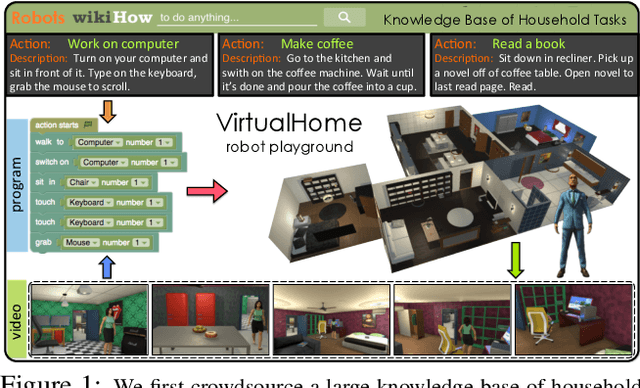



Abstract:In this paper, we are interested in modeling complex activities that occur in a typical household. We propose to use programs, i.e., sequences of atomic actions and interactions, as a high level representation of complex tasks. Programs are interesting because they provide a non-ambiguous representation of a task, and allow agents to execute them. However, nowadays, there is no database providing this type of information. Towards this goal, we first crowd-source programs for a variety of activities that happen in people's homes, via a game-like interface used for teaching kids how to code. Using the collected dataset, we show how we can learn to extract programs directly from natural language descriptions or from videos. We then implement the most common atomic (inter)actions in the Unity3D game engine, and use our programs to "drive" an artificial agent to execute tasks in a simulated household environment. Our VirtualHome simulator allows us to create a large activity video dataset with rich ground-truth, enabling training and testing of video understanding models. We further showcase examples of our agent performing tasks in our VirtualHome based on language descriptions.
 Add to Chrome
Add to Chrome Add to Firefox
Add to Firefox Add to Edge
Add to Edge